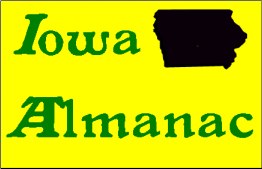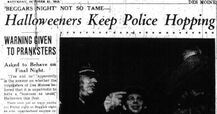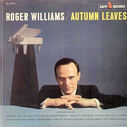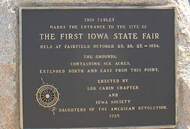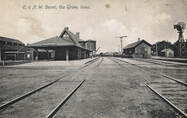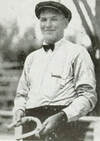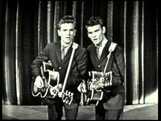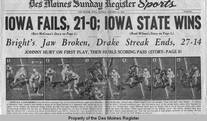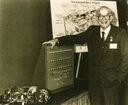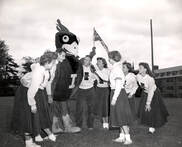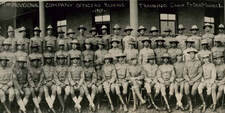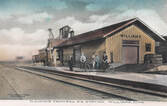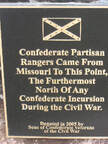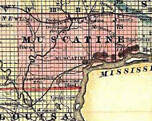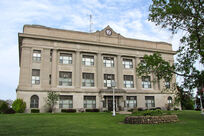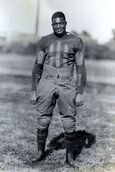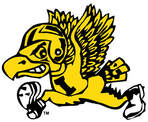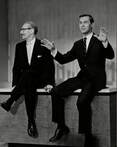"Iowa Almanac" is a copyrighted production of Stein Enterprises, L.L.C.
All Rights Reserved.
No use of the material is allowed without prior written permission of the copyright holder.
Copyright 2020 by Stein Enterprises, L.L.C.
All Rights Reserved.
No use of the material is allowed without prior written permission of the copyright holder.
Copyright 2020 by Stein Enterprises, L.L.C.
Iowa Almanac for Friday, October 30, 2020
"Begging Door to Door"
In the 1930s, Halloween in Des Moines was focused more on vandalism than going door to door for treats. Police there responded to a record 550 calls of vandalism in one year alone.
The director of what is now the parks and rec department, Kathryn Krieg, came up with a campaign to encourage less destructive forms of fun.
In 1938, the city set aside October 30th as Beggars’ Night, encouraging children on that night only to go door to door and say the phrase, “Tricks for Eats”. The city council said “eats should be given only if such a ‘trick’ as a song, a poem, a stunt or a musical number, either solo or in group participation, is presented.”
The Beggars’ Night program worked. By the mid-1940s, the number of Halloween police calls in Iowa’s capital city had been cut by more than half.
There was a down side, though. Some of the worst jokes and riddles ever have been told as part of the yearly event.
Kathryn Krieg retired in 1974 after 43 years on the job. Her yearly reminders to make children work for their Halloween candy were carried by local media for parts of five different decades. She died in 1999 at the age of 94, but her legacy is intact today.
The first Beggars’ Night in Des Moines, where children said “Tricks for Eats” and then were held to it, was on this date in 1938.
And that's Iowa Almanac for October 30th...Listen to the extended audio version of today's story by clicking on the audio player above.
"Begging Door to Door"
In the 1930s, Halloween in Des Moines was focused more on vandalism than going door to door for treats. Police there responded to a record 550 calls of vandalism in one year alone.
The director of what is now the parks and rec department, Kathryn Krieg, came up with a campaign to encourage less destructive forms of fun.
In 1938, the city set aside October 30th as Beggars’ Night, encouraging children on that night only to go door to door and say the phrase, “Tricks for Eats”. The city council said “eats should be given only if such a ‘trick’ as a song, a poem, a stunt or a musical number, either solo or in group participation, is presented.”
The Beggars’ Night program worked. By the mid-1940s, the number of Halloween police calls in Iowa’s capital city had been cut by more than half.
There was a down side, though. Some of the worst jokes and riddles ever have been told as part of the yearly event.
Kathryn Krieg retired in 1974 after 43 years on the job. Her yearly reminders to make children work for their Halloween candy were carried by local media for parts of five different decades. She died in 1999 at the age of 94, but her legacy is intact today.
The first Beggars’ Night in Des Moines, where children said “Tricks for Eats” and then were held to it, was on this date in 1938.
And that's Iowa Almanac for October 30th...Listen to the extended audio version of today's story by clicking on the audio player above.
Iowa Almanac for Thursday, October 29, 2020
"Autumn Leaves Rising, Not Falling"
Early on, people in Des Moines knew Louis Weertz had talent. His father was a minister; his mother, a music teacher. The family moved to Des Moines before Louis was even a year old, and by the time he was three, he was already playing the piano…by ear.
His studies in piano at Drake University were interrupted by World War II, but he later returned to Drake and earned a masters degree. After that, it was on to the famous Julliard School. While in New York, he won a national TV talent contest. The founder of Kapp Records heard him play and signed him to a recording contract.
And that’s how Louis Weertz became known as Roger Williams.
In 1955, Roger Williams recorded “Autumn Leaves”. It became the only piano instrumental to ever reach number one on Billboard magazine’s pop music chart. It was the fourth number one song of the rock era and first moved to the top of the chart on October 29th of that year.
It stayed at number one for four weeks, and wound up being the fourth most popular song of the whole year.
Roger Williams scored 18 gold and platinum albums, and played for nine U.S. presidents, ranging from Harry S. Truman to George W. Bush.
He died of pancreatic cancer in 2011, just a week after his 87th birthday.
Iowa’s Louis Weertz—known to the world as pianist Roger Williams—went to number one on the pop charts with “Autumn Leaves”, on this date in 1955.
And that's Iowa Almanac for October 29th...Listen to the extended audio version of today's story by clicking on the audio player above.
"Autumn Leaves Rising, Not Falling"
Early on, people in Des Moines knew Louis Weertz had talent. His father was a minister; his mother, a music teacher. The family moved to Des Moines before Louis was even a year old, and by the time he was three, he was already playing the piano…by ear.
His studies in piano at Drake University were interrupted by World War II, but he later returned to Drake and earned a masters degree. After that, it was on to the famous Julliard School. While in New York, he won a national TV talent contest. The founder of Kapp Records heard him play and signed him to a recording contract.
And that’s how Louis Weertz became known as Roger Williams.
In 1955, Roger Williams recorded “Autumn Leaves”. It became the only piano instrumental to ever reach number one on Billboard magazine’s pop music chart. It was the fourth number one song of the rock era and first moved to the top of the chart on October 29th of that year.
It stayed at number one for four weeks, and wound up being the fourth most popular song of the whole year.
Roger Williams scored 18 gold and platinum albums, and played for nine U.S. presidents, ranging from Harry S. Truman to George W. Bush.
He died of pancreatic cancer in 2011, just a week after his 87th birthday.
Iowa’s Louis Weertz—known to the world as pianist Roger Williams—went to number one on the pop charts with “Autumn Leaves”, on this date in 1955.
And that's Iowa Almanac for October 29th...Listen to the extended audio version of today's story by clicking on the audio player above.
Iowa Almanac for Wednesday, October 28, 2020
"First In The Nation"
Ever since the first Iowa presidential precinct caucus in 1972, Iowa has become a popular place for those who seek the nation's highest office, especially since a relative unknown named Jimmy Carter used a strong showing in the 1976 event to ultimately win his party's nomination and later the presidency.
In those early days, the caucus was held in late January, and for many years, in mid to late February. But as Iowa's role in the process became more prominent, other states wanted to leapfrog Iowa and be first in the nation.
That led to party rules declaring that Iowa would be the first in the nation caucus state, and New Hampshire would host the first in the nation primary. But other states kept inching earlier and earlier, and there was a real danger that Iowa would actually have to hold its 2008 caucuses in calendar year 2007 in order to remain first.
On October 28th, 2007, representatives of the Iowa Democratic Party voted to move the caucuses to January 3rd, 2008, just about as early as possible while still being in the year of the election. Earlier in the month, our state's Republicans did the same thing, continuing a then-30-year trend of the two parties holding their respective caucuses on the same night, to maximize national exposure.
Despite threats, no other state moved ahead of Iowa, and on January 3rd, 2008, 38 percent of Iowa Democrats chose a U.S. Senator from Illinois, Barack Obama, as their choice for president, edging former U.S. Senator John Edwards from North Carolina with 30 percent. Obama, of course, went on to win the nomination and the election to become the first non-Caucasian to hold the presidency.
The date for that historic caucus was set when Iowa Democrats moved the event to an earlier date to remain first in the nation; a decision made on this date in 2007.
And that's Iowa Almanac for October 28th...Listen to the extended audio version of today's story by clicking on the audio player above.
"First In The Nation"
Ever since the first Iowa presidential precinct caucus in 1972, Iowa has become a popular place for those who seek the nation's highest office, especially since a relative unknown named Jimmy Carter used a strong showing in the 1976 event to ultimately win his party's nomination and later the presidency.
In those early days, the caucus was held in late January, and for many years, in mid to late February. But as Iowa's role in the process became more prominent, other states wanted to leapfrog Iowa and be first in the nation.
That led to party rules declaring that Iowa would be the first in the nation caucus state, and New Hampshire would host the first in the nation primary. But other states kept inching earlier and earlier, and there was a real danger that Iowa would actually have to hold its 2008 caucuses in calendar year 2007 in order to remain first.
On October 28th, 2007, representatives of the Iowa Democratic Party voted to move the caucuses to January 3rd, 2008, just about as early as possible while still being in the year of the election. Earlier in the month, our state's Republicans did the same thing, continuing a then-30-year trend of the two parties holding their respective caucuses on the same night, to maximize national exposure.
Despite threats, no other state moved ahead of Iowa, and on January 3rd, 2008, 38 percent of Iowa Democrats chose a U.S. Senator from Illinois, Barack Obama, as their choice for president, edging former U.S. Senator John Edwards from North Carolina with 30 percent. Obama, of course, went on to win the nomination and the election to become the first non-Caucasian to hold the presidency.
The date for that historic caucus was set when Iowa Democrats moved the event to an earlier date to remain first in the nation; a decision made on this date in 2007.
And that's Iowa Almanac for October 28th...Listen to the extended audio version of today's story by clicking on the audio player above.
Iowa Almanac for Tuesday, October 27, 2020
"Our State Fair Is A Great State Fair"
We’re used to the Iowa State Fair lasting more than two weeks, and being a focus of our late summer, August activities.
But it wasn’t always that way.
The first Iowa State Fair was held after harvest, from October 25th through the 27th, 1854. The fair was staged in Fairfield on a budget of only $323. There was no railroad at the time in Fairfield; that was still four years off.
Fairfield hosted the event the next year as well, before moving from town to town for the next 20 years. Muscatine, Oskaloosa, Iowa City, Dubuque, Burlington, Clinton, and Keokuk each hosted the fair for two year terms; Cedar Rapids played host twice, for a total of four years.
The Iowa State Fair moved to Des Moines permanently in 1878. It has been at its current location, at East 30th and East Grand Avenue, since 1886.
Since that first year, the Fair has been cancelled only six times—this year, due to the pandemic and five other times due to war…the Spanish-American War in 1898, and for four years during World War II.
That first fair opened with presentation of a 360-pound “Great Denmark Cheese” to Iowa’s governor-elect James Grimes, from his friends from Lee County. The final day of the fair featured ten girls showing off their equestrian skills. Belle Turner of Lee County won first prize and a gold watch, but popular sentiment for a poor girl, 14-year-old Eliza Jane Hodges of Iowa City, led to $165 in cash and six month’s school tuition being raised for her from the crowd on the spot.
It cost 25 cents to get in, and first place winners got red ribbons, not the blue ribbons we know today. Some 10,000 people attended part of the three days of that first Iowa State Fair, which wrapped up in Fairfield on this date in 1854.
And that's Iowa Almanac for October 27th...Listen to the extended audio version of today's story by clicking on the audio player above.
"Our State Fair Is A Great State Fair"
We’re used to the Iowa State Fair lasting more than two weeks, and being a focus of our late summer, August activities.
But it wasn’t always that way.
The first Iowa State Fair was held after harvest, from October 25th through the 27th, 1854. The fair was staged in Fairfield on a budget of only $323. There was no railroad at the time in Fairfield; that was still four years off.
Fairfield hosted the event the next year as well, before moving from town to town for the next 20 years. Muscatine, Oskaloosa, Iowa City, Dubuque, Burlington, Clinton, and Keokuk each hosted the fair for two year terms; Cedar Rapids played host twice, for a total of four years.
The Iowa State Fair moved to Des Moines permanently in 1878. It has been at its current location, at East 30th and East Grand Avenue, since 1886.
Since that first year, the Fair has been cancelled only six times—this year, due to the pandemic and five other times due to war…the Spanish-American War in 1898, and for four years during World War II.
That first fair opened with presentation of a 360-pound “Great Denmark Cheese” to Iowa’s governor-elect James Grimes, from his friends from Lee County. The final day of the fair featured ten girls showing off their equestrian skills. Belle Turner of Lee County won first prize and a gold watch, but popular sentiment for a poor girl, 14-year-old Eliza Jane Hodges of Iowa City, led to $165 in cash and six month’s school tuition being raised for her from the crowd on the spot.
It cost 25 cents to get in, and first place winners got red ribbons, not the blue ribbons we know today. Some 10,000 people attended part of the three days of that first Iowa State Fair, which wrapped up in Fairfield on this date in 1854.
And that's Iowa Almanac for October 27th...Listen to the extended audio version of today's story by clicking on the audio player above.
Iowa Almanac for Monday, October 26, 2020
"The Ida Grove Train"
Just a few years after Iowa became a state, surveyors were running township lines in what is now Ida County. The name does not refer to a famous citizen, nor is it a derivative of a Native American word.
The surveyors noted that Native Americans in the area had camped on a high hill west of where the town of Ida Grove was later established. They had fires burning on the top of that hill, drying strips of meat over green sampling frames so it would not spoil during the winter. The fires were visible through the night, reminding the surveyors of the vestal fires on Mount Ida in Greece.
And that’s how Ida County got its name.
A nearby grove of trees was in place near what became the John Moorehead home, also known as the Stagecoach Inn because it was placed at the crossroads of least five small stagecoach lines. Martha Moorehead had a habit of naming their family homes, and dubbed this one Ida Grove.
And as more buildings went up, as more settlers moved into the area, a town developed near that grove of trees…named Ida Grove.
The Stagecoach Inn became the first post office for the town, and later the first county courthouse.
The stagecoach lines gave way to the arrival of the railroad, and the first Chicago and Northwestern Railroad train made its way through Ida Grove on October 26th, 1877. As was often the case after rail service, the town grew quickly.
A new courthouse was built, on Moorehead Street, named after the original settlers of Ida Grove, which was officially named when the first train arrived in town, on this date in 1877.
And that's Iowa Almanac for October 26th...Listen to the extended audio version of today's story by clicking on the audio player above.
"The Ida Grove Train"
Just a few years after Iowa became a state, surveyors were running township lines in what is now Ida County. The name does not refer to a famous citizen, nor is it a derivative of a Native American word.
The surveyors noted that Native Americans in the area had camped on a high hill west of where the town of Ida Grove was later established. They had fires burning on the top of that hill, drying strips of meat over green sampling frames so it would not spoil during the winter. The fires were visible through the night, reminding the surveyors of the vestal fires on Mount Ida in Greece.
And that’s how Ida County got its name.
A nearby grove of trees was in place near what became the John Moorehead home, also known as the Stagecoach Inn because it was placed at the crossroads of least five small stagecoach lines. Martha Moorehead had a habit of naming their family homes, and dubbed this one Ida Grove.
And as more buildings went up, as more settlers moved into the area, a town developed near that grove of trees…named Ida Grove.
The Stagecoach Inn became the first post office for the town, and later the first county courthouse.
The stagecoach lines gave way to the arrival of the railroad, and the first Chicago and Northwestern Railroad train made its way through Ida Grove on October 26th, 1877. As was often the case after rail service, the town grew quickly.
A new courthouse was built, on Moorehead Street, named after the original settlers of Ida Grove, which was officially named when the first train arrived in town, on this date in 1877.
And that's Iowa Almanac for October 26th...Listen to the extended audio version of today's story by clicking on the audio player above.
Iowa Almanac for Friday, October 23, 2020
"Championship Horseshoe Pitching"
Frank Elroy Jackson was a farmer near Kellerton, Iowa, in Ringgold County. To pass the time, he like many others enjoyed horseshoe pitching. But Frank Jackson took it to a new level.
He first got a taste of competition in 1910, just as he was turning 40 years of age. He saw how others had tossed the horseshoes, and was surprised. He had never heard of being able to hold a shoe so it would open toward the stake. Instead, he had been holding the shoe with his finger around the heel calk.
At the time, games were played on dirt or sand courts, with stakes sticking two inches high off the ground, and placed 38 feet apart. Frank Jackson had developed the skill of pitching a ringer over that two inch stake, then laying a second shoe on top of the stake so opponents could not keep their ringers on. Later, the stake height was adjusted to six inches.
Jackson took it seriously, using a pair of shoes he had specially made by a local blacksmith, who bent the calks so the shoe would slide better in the sand, and help him slide ringers on the stake.
The first national horseshoe pitching tournament was held on October 23rd, 1915, in Kansas City, Kansas. And Frank Jackson won the title. He held it for four years, and was never defeated in competition.
Wearing a battered old felt hat, a long-sleeved shirt with a skinny necktie tucked in near one of the top buttons, and unpressed pants held up by suspenders, Kellerton, Iowa’s Frank Elroy Jackson became the national horseshoe pitching champion, on this date in 1915.
And that's Iowa Almanac for October 23rd...Listen to the extended audio version of today's story by clicking on the audio player above.
"Championship Horseshoe Pitching"
Frank Elroy Jackson was a farmer near Kellerton, Iowa, in Ringgold County. To pass the time, he like many others enjoyed horseshoe pitching. But Frank Jackson took it to a new level.
He first got a taste of competition in 1910, just as he was turning 40 years of age. He saw how others had tossed the horseshoes, and was surprised. He had never heard of being able to hold a shoe so it would open toward the stake. Instead, he had been holding the shoe with his finger around the heel calk.
At the time, games were played on dirt or sand courts, with stakes sticking two inches high off the ground, and placed 38 feet apart. Frank Jackson had developed the skill of pitching a ringer over that two inch stake, then laying a second shoe on top of the stake so opponents could not keep their ringers on. Later, the stake height was adjusted to six inches.
Jackson took it seriously, using a pair of shoes he had specially made by a local blacksmith, who bent the calks so the shoe would slide better in the sand, and help him slide ringers on the stake.
The first national horseshoe pitching tournament was held on October 23rd, 1915, in Kansas City, Kansas. And Frank Jackson won the title. He held it for four years, and was never defeated in competition.
Wearing a battered old felt hat, a long-sleeved shirt with a skinny necktie tucked in near one of the top buttons, and unpressed pants held up by suspenders, Kellerton, Iowa’s Frank Elroy Jackson became the national horseshoe pitching champion, on this date in 1915.
And that's Iowa Almanac for October 23rd...Listen to the extended audio version of today's story by clicking on the audio player above.
Iowa Almanac for Thursday, October 22, 2020
"Letterman Comes To Iowa"
In May of 2015, David Letterman ended his record-setting 33 years hosting late night TV shows. Many forget that his first TV show was on at a very different time, and had a very different audience.
The David Letterman Show aired at 9 a.m. Iowa time for a four month period in the summer and fall of 1980. It wound up winning an Emmy, but it was a little too unique for an audience used to game shows and soap operas, as opposed to a comedian with quirky humor.
As an example…the show sponsored an essay contest, encouraging viewers to write and tell why Letterman and his New York-based crew should tape an episode at your house. Jane Goldsworthy of Cresco, Iowa, submitted a 100-word essay, and before long, she found out she had won.
And that was how Howard and Jane Goldsworthy became national TV stars for a day, on October 22nd, 1980. The Letterman program that day included taped man-on-the-street segments from downtown Cresco, stupid pet tricks, and guest Cloris Leachman, herself an Iowa native.
The show almost did not make it on the air. It was taped in the late summer, and then the show was cancelled. But just before the last daytime Letterman program on October 24th, the producers made sure the Iowa episode aired, on this date, in 1980.
And that's Iowa Almanac for October 22nd...Listen to the extended audio version of today's story by clicking on the audio player above.
"Letterman Comes To Iowa"
In May of 2015, David Letterman ended his record-setting 33 years hosting late night TV shows. Many forget that his first TV show was on at a very different time, and had a very different audience.
The David Letterman Show aired at 9 a.m. Iowa time for a four month period in the summer and fall of 1980. It wound up winning an Emmy, but it was a little too unique for an audience used to game shows and soap operas, as opposed to a comedian with quirky humor.
As an example…the show sponsored an essay contest, encouraging viewers to write and tell why Letterman and his New York-based crew should tape an episode at your house. Jane Goldsworthy of Cresco, Iowa, submitted a 100-word essay, and before long, she found out she had won.
And that was how Howard and Jane Goldsworthy became national TV stars for a day, on October 22nd, 1980. The Letterman program that day included taped man-on-the-street segments from downtown Cresco, stupid pet tricks, and guest Cloris Leachman, herself an Iowa native.
The show almost did not make it on the air. It was taped in the late summer, and then the show was cancelled. But just before the last daytime Letterman program on October 24th, the producers made sure the Iowa episode aired, on this date, in 1980.
And that's Iowa Almanac for October 22nd...Listen to the extended audio version of today's story by clicking on the audio player above.
Iowa Almanac for Wednesday, October 21, 2020
"Iowa Brothers Top The Charts"
Given the family history, it was no surprise that Phillip and Donald Everly would turn to music. Their father, Ike, had developed a unique style of guitar playing and soon was a full-time musician. Ike and Margaret moved their family to Shenandoah so Ike could take a job performing on KMA radio. Little Donnie and Baby Boy Phil soon joined their parents on the air, when they were only 8 and 6 years old.
The Everlys lived in Shenandoah from 1945 to 1952…not long after, America knew of the brothers thanks to their first single, “Bye Bye Love”, which peaked at number 2 on the pop charts in 1957.
Their next single, though, went to the very top.
“Wake Up Little Susie” hit number one in Billboard magazine’s chart on October 21, 1957. It stayed at number one for four weeks and became their second million selling record in a row. Don was 20, Phil was 18.
The Everly Brothers were among the first 10 artists inducted into the Rock and Roll Hall of Fame. Together they had 35 Billboard Hot 100 singles…26 of those made the Top 40. But their first number one hit, “Wake Up Little Susie”, first topped the pop charts on this date in 1957.
And that's Iowa Almanac for October 21st...Listen to the extended audio version of today's story by clicking on the audio player above.
"Iowa Brothers Top The Charts"
Given the family history, it was no surprise that Phillip and Donald Everly would turn to music. Their father, Ike, had developed a unique style of guitar playing and soon was a full-time musician. Ike and Margaret moved their family to Shenandoah so Ike could take a job performing on KMA radio. Little Donnie and Baby Boy Phil soon joined their parents on the air, when they were only 8 and 6 years old.
The Everlys lived in Shenandoah from 1945 to 1952…not long after, America knew of the brothers thanks to their first single, “Bye Bye Love”, which peaked at number 2 on the pop charts in 1957.
Their next single, though, went to the very top.
“Wake Up Little Susie” hit number one in Billboard magazine’s chart on October 21, 1957. It stayed at number one for four weeks and became their second million selling record in a row. Don was 20, Phil was 18.
The Everly Brothers were among the first 10 artists inducted into the Rock and Roll Hall of Fame. Together they had 35 Billboard Hot 100 singles…26 of those made the Top 40. But their first number one hit, “Wake Up Little Susie”, first topped the pop charts on this date in 1957.
And that's Iowa Almanac for October 21st...Listen to the extended audio version of today's story by clicking on the audio player above.
Iowa Almanac for Tuesday, October 20, 2020
"A Racist Attack On The Field"
Johnny Bright was a star halfback and quarterback for the Drake Bulldogs. In 1951, he was a pre-season Heisman Trophy candidate, and led the nation in total offense.
Drake was riding a five-game winning streak that season when the Bulldogs traveled to Oklahoma A&M, now Oklahoma State, on October 20th of that year. Two years before, Bright had been the first African-American to play on the Aggie’s home turf at Lewis Field.
It was no secret that A&M players were targeting Bright. Newspapers in Stillwater wrote that Bright was a marked man.
During the first seven minutes of the game alone, Bright was knocked unconscious three times by shots by A&M defensive tackle Wilbanks Smith. That last shot broke Johnny Bright’s jaw, but he still completed a 61-yard touchdown pass a few plays later. He did have to leave the game due to his injuries and the Bulldogs lost 27-14.
Given the times, it was hard to get some people to believe that Bright was targeted. But a six-photograph sequence of the final shot to Bright’s jaw, taken by Des Moines Register photographers Don Ultang and John Robinson, proved the case, winning the pair a Pulitzer Prize in the process.
When it became clear the Missouri Valley Conference was not going to take action against Oklahoma A&M, Drake actually withdrew from the conference in protest, not returning as a football member for 20 years.
Johnny Bright finished fifth in the Heisman voting, despite missing most of the last three games of that season because of the injury. He later spent 12 years in the professional Canadian Football League and was inducted into the league’s hall of fame.
In 2005, the president of Oklahoma State wrote a letter to Drake’s president, formally apologizing for the incident. But it came 22 years after Johnny Bright died.
Drake’s star was brutally knocked out of the game, simply because of his race, on this date in 1951.
And that's Iowa Almanac for October 20th...Listen to the extended audio version of today's story by clicking on the audio player above.
"A Racist Attack On The Field"
Johnny Bright was a star halfback and quarterback for the Drake Bulldogs. In 1951, he was a pre-season Heisman Trophy candidate, and led the nation in total offense.
Drake was riding a five-game winning streak that season when the Bulldogs traveled to Oklahoma A&M, now Oklahoma State, on October 20th of that year. Two years before, Bright had been the first African-American to play on the Aggie’s home turf at Lewis Field.
It was no secret that A&M players were targeting Bright. Newspapers in Stillwater wrote that Bright was a marked man.
During the first seven minutes of the game alone, Bright was knocked unconscious three times by shots by A&M defensive tackle Wilbanks Smith. That last shot broke Johnny Bright’s jaw, but he still completed a 61-yard touchdown pass a few plays later. He did have to leave the game due to his injuries and the Bulldogs lost 27-14.
Given the times, it was hard to get some people to believe that Bright was targeted. But a six-photograph sequence of the final shot to Bright’s jaw, taken by Des Moines Register photographers Don Ultang and John Robinson, proved the case, winning the pair a Pulitzer Prize in the process.
When it became clear the Missouri Valley Conference was not going to take action against Oklahoma A&M, Drake actually withdrew from the conference in protest, not returning as a football member for 20 years.
Johnny Bright finished fifth in the Heisman voting, despite missing most of the last three games of that season because of the injury. He later spent 12 years in the professional Canadian Football League and was inducted into the league’s hall of fame.
In 2005, the president of Oklahoma State wrote a letter to Drake’s president, formally apologizing for the incident. But it came 22 years after Johnny Bright died.
Drake’s star was brutally knocked out of the game, simply because of his race, on this date in 1951.
And that's Iowa Almanac for October 20th...Listen to the extended audio version of today's story by clicking on the audio player above.
Iowa Almanac for Monday, October 19, 2020
"The True Father of the Computer"
Computers, and the latest technology computers have spawned, dominate our lives. It’s hard to imagine a time without them.
Who deserves the credit for inventing the computer has been hotly contested over time.
One night in the late 1930s, Iowa State University physics professor John Vincent Atanasoff was working in his lab. He had a particularly frustrating day, performing tedious mathematical calculations. So he left work and went to a bar to relax.
He wanted to find a way to make working those calculations easier. It was in that bar that he came upon the idea that a binary number system and electronic switches, combined with an array of capacitors on a moving drum to serve as memory, could produce a computing machine that would make his life easier.
So he went back and built the machine. It worked, and nearly two years later, in 1939, Atanasoff and graduate student Clifford Berry built a prototype of the ABC…the Atanasoff-Berry Computer.
But he never patented the device, and others took the foundation developed by Atanasoff to create machines that advanced the ABC.
Lawsuits later resulted, because if the ABC was in fact the foundation of more modern computers, a lot of money was at stake.
On October 19, 1973, a judge ruled that the fight at the time between Honeywell and Sperry-Rand over who invented the computer missed the point…because the true father of the computer was John Atanasoff.
The decision came just two weeks after his 70th birthday. From that point on, John Atanasoff’s name would go down in history. Recognition that the Iowa State professor invented the first electronic digital computer came in a court decision, on this date, in 1973.
And that's Iowa Almanac for October 19th...Listen to the extended audio version of today's story by clicking on the audio player above.
"The True Father of the Computer"
Computers, and the latest technology computers have spawned, dominate our lives. It’s hard to imagine a time without them.
Who deserves the credit for inventing the computer has been hotly contested over time.
One night in the late 1930s, Iowa State University physics professor John Vincent Atanasoff was working in his lab. He had a particularly frustrating day, performing tedious mathematical calculations. So he left work and went to a bar to relax.
He wanted to find a way to make working those calculations easier. It was in that bar that he came upon the idea that a binary number system and electronic switches, combined with an array of capacitors on a moving drum to serve as memory, could produce a computing machine that would make his life easier.
So he went back and built the machine. It worked, and nearly two years later, in 1939, Atanasoff and graduate student Clifford Berry built a prototype of the ABC…the Atanasoff-Berry Computer.
But he never patented the device, and others took the foundation developed by Atanasoff to create machines that advanced the ABC.
Lawsuits later resulted, because if the ABC was in fact the foundation of more modern computers, a lot of money was at stake.
On October 19, 1973, a judge ruled that the fight at the time between Honeywell and Sperry-Rand over who invented the computer missed the point…because the true father of the computer was John Atanasoff.
The decision came just two weeks after his 70th birthday. From that point on, John Atanasoff’s name would go down in history. Recognition that the Iowa State professor invented the first electronic digital computer came in a court decision, on this date, in 1973.
And that's Iowa Almanac for October 19th...Listen to the extended audio version of today's story by clicking on the audio player above.
Iowa Almanac for Friday, October 16, 2020
"Cy Takes The Field"
The Iowa State athletic teams have been known as the Cyclones since 1895. That’s when the Chicago Tribune said the Northwestern football team had been “struck by a cyclone” when the team from Ames came to town. The name stuck.
But it’s hard to have a cyclone as a mascot. After all, what costume would you come up with?
In 1954, members of Iowa State’s Pep Council decided the university needed a mascot. They decided on a cardinal, since the school colors are cardinal and gold. A contest was held to name the new mascot, and 17 people submitted the name “Cy”, short for “Cyclone”.
Cy the Cardinal made his debut at Homecoming on October 16, 1954. That first Cy was 8 feet tall and the costume cost $200 to create.
A slightly more agile version of the mascot, named Clone, debuted in 1989. Cy and Clone both served for a number of years, before being merged in 1995 into the Cy who prowls the sidelines on game day today.
Cy the Cardinal won a national mascot of the year contest in 2008, but he made his debut at Homecoming, on this date, in 1954.
And that's Iowa Almanac for October 16th...Listen to the extended audio version of today's story by clicking on the audio player above.
"Cy Takes The Field"
The Iowa State athletic teams have been known as the Cyclones since 1895. That’s when the Chicago Tribune said the Northwestern football team had been “struck by a cyclone” when the team from Ames came to town. The name stuck.
But it’s hard to have a cyclone as a mascot. After all, what costume would you come up with?
In 1954, members of Iowa State’s Pep Council decided the university needed a mascot. They decided on a cardinal, since the school colors are cardinal and gold. A contest was held to name the new mascot, and 17 people submitted the name “Cy”, short for “Cyclone”.
Cy the Cardinal made his debut at Homecoming on October 16, 1954. That first Cy was 8 feet tall and the costume cost $200 to create.
A slightly more agile version of the mascot, named Clone, debuted in 1989. Cy and Clone both served for a number of years, before being merged in 1995 into the Cy who prowls the sidelines on game day today.
Cy the Cardinal won a national mascot of the year contest in 2008, but he made his debut at Homecoming, on this date, in 1954.
And that's Iowa Almanac for October 16th...Listen to the extended audio version of today's story by clicking on the audio player above.
Iowa Almanac for Thursday, October 15, 2020
"Graduating Cadets"
The United States entered World War I in 1917, and thousands of Americans enlisted to fight Germany in the Great War. That included thousands of black Americans, from all parts of the country.
Keep in mind this was only 50 years after the end of the U.S. Civil War.
Despite the eagerness of some blacks to join the fight, enlistments were limited by the federal government. While some groups such as the NAACP pushed for officer training for blacks, government officials were afraid the race issue would hurt the war effort.
So a compromise was reached, whereby one officer candidate school in the country would be open to blacks. It was located at Fort Des Moines.
Fort Des Moines had been built on 400 acres of land in 1901 and had previously hosted all-black units for training.
The first black officer candidates arrived at Fort Des Moines in May of 1917, consisting of 1,000 black college graduates and faculty members. At the time, Des Moines’ black population only numbered 5,000.
The troops were highly educated, and well received by the community. That was in contrast to an all-black Alabama enlisted regiment based at Camp Dodge across town, which often faced discrimination.
After 90 days of rigorous training, 638 captains and lieutenants received their commissions and were dispatched for basic training across the country. They would reunite in New Jersey in June of the next year, to fight as a unit in France.
Graduation day for the country’s only class of black officers, trained at Fort Des Moines, happened on this date in 1917.
And that's Iowa Almanac for October 15th...Listen to the extended audio version of today's story by clicking on the audio player above.
"Graduating Cadets"
The United States entered World War I in 1917, and thousands of Americans enlisted to fight Germany in the Great War. That included thousands of black Americans, from all parts of the country.
Keep in mind this was only 50 years after the end of the U.S. Civil War.
Despite the eagerness of some blacks to join the fight, enlistments were limited by the federal government. While some groups such as the NAACP pushed for officer training for blacks, government officials were afraid the race issue would hurt the war effort.
So a compromise was reached, whereby one officer candidate school in the country would be open to blacks. It was located at Fort Des Moines.
Fort Des Moines had been built on 400 acres of land in 1901 and had previously hosted all-black units for training.
The first black officer candidates arrived at Fort Des Moines in May of 1917, consisting of 1,000 black college graduates and faculty members. At the time, Des Moines’ black population only numbered 5,000.
The troops were highly educated, and well received by the community. That was in contrast to an all-black Alabama enlisted regiment based at Camp Dodge across town, which often faced discrimination.
After 90 days of rigorous training, 638 captains and lieutenants received their commissions and were dispatched for basic training across the country. They would reunite in New Jersey in June of the next year, to fight as a unit in France.
Graduation day for the country’s only class of black officers, trained at Fort Des Moines, happened on this date in 1917.
And that's Iowa Almanac for October 15th...Listen to the extended audio version of today's story by clicking on the audio player above.
Iowa Almanac for Wednesday, October 14, 2020
"A Fruit Pie"
Anita Bryant was known in the 1950s and 1960s as a singer, then as the commercial spokesperson for Florida orange juice.
By the mid-1970s, she became active in the anti-gay rights movement, first in Florida, and then around the country.
That's what led her to come to Des Moines on October 14th, 1977. Only two months before, her efforts led to repeal of an anti-discrimination ordinance in her home state. She was speaking at a news conference when suddenly a gay rights activist from Minnesota named Thom Higgins hit Bryant in the face with a cream pie.
Immediately afterward, Bryant and her husband Bob Green prayed for God to forgive the activist for his deviant lifestyle. Higgins was one of four who attended the news conference to protest against Bryant. They brought with them a spare pie. Bryant's husband confronted the four outside the news conference, and tossed that spare pie into the face of one of the protestors.
No charges were filed.
It's been more than 40 years, and the issue of gay rights still raises controversy. One of the most public displays of the dispute came in Des Moines when Anita Bryant was hit in the face with a pie by a gay rights activist, on this date, in 1977.
And that's Iowa Almanac for October 14th...Listen to the extended audio version of today's story by clicking on the audio player above.
"A Fruit Pie"
Anita Bryant was known in the 1950s and 1960s as a singer, then as the commercial spokesperson for Florida orange juice.
By the mid-1970s, she became active in the anti-gay rights movement, first in Florida, and then around the country.
That's what led her to come to Des Moines on October 14th, 1977. Only two months before, her efforts led to repeal of an anti-discrimination ordinance in her home state. She was speaking at a news conference when suddenly a gay rights activist from Minnesota named Thom Higgins hit Bryant in the face with a cream pie.
Immediately afterward, Bryant and her husband Bob Green prayed for God to forgive the activist for his deviant lifestyle. Higgins was one of four who attended the news conference to protest against Bryant. They brought with them a spare pie. Bryant's husband confronted the four outside the news conference, and tossed that spare pie into the face of one of the protestors.
No charges were filed.
It's been more than 40 years, and the issue of gay rights still raises controversy. One of the most public displays of the dispute came in Des Moines when Anita Bryant was hit in the face with a pie by a gay rights activist, on this date, in 1977.
And that's Iowa Almanac for October 14th...Listen to the extended audio version of today's story by clicking on the audio player above.
Iowa Almanac for Tuesday, October 13, 2020
"A Post Office Before The Town"
A U.S. post office was established in the town of Williams, Iowa on this date, October 13th, in 1869.
But it wasn't very busy. That's because at the time the post office was established, the town had not even been platted.
William H. Merritt owned a number of parcels of land in Iowa at that time, and thanks to the growing railroad, set up a number of small towns through which rail lines could run.
That was the case with Williams, located in Hamilton County. The town was not platted until the winter of 1869 and the only building that was built was the railroad depot. The first postmaster was Isaac H. Brown, who also served as the depot agent...truly a one-man town.
Merritt named his town for Major William Williams of Fort Dodge.
The first house in Williams was built in 1870, but by 1900, the town had a population of 500. It was among the first in Iowa to have a complete water and sewage system, and in 1930, it was chosen by Bell Telephone as the first rural community west of the Mississippi to have dial telephones.
And one of the town's favorite sons, Al McCoy, has been the play by play voice of the Phoenix Suns NBA team since 1972 and was inducted into the Basketball Hall of Fame in 2007.
There were no homes and no citizens, but you could send a letter to the post office in Williams, Iowa, which was established on this date in 1869.
And that's Iowa Almanac for October 13th...Listen to the extended audio version of today's story by clicking on the audio player above.
"A Post Office Before The Town"
A U.S. post office was established in the town of Williams, Iowa on this date, October 13th, in 1869.
But it wasn't very busy. That's because at the time the post office was established, the town had not even been platted.
William H. Merritt owned a number of parcels of land in Iowa at that time, and thanks to the growing railroad, set up a number of small towns through which rail lines could run.
That was the case with Williams, located in Hamilton County. The town was not platted until the winter of 1869 and the only building that was built was the railroad depot. The first postmaster was Isaac H. Brown, who also served as the depot agent...truly a one-man town.
Merritt named his town for Major William Williams of Fort Dodge.
The first house in Williams was built in 1870, but by 1900, the town had a population of 500. It was among the first in Iowa to have a complete water and sewage system, and in 1930, it was chosen by Bell Telephone as the first rural community west of the Mississippi to have dial telephones.
And one of the town's favorite sons, Al McCoy, has been the play by play voice of the Phoenix Suns NBA team since 1972 and was inducted into the Basketball Hall of Fame in 2007.
There were no homes and no citizens, but you could send a letter to the post office in Williams, Iowa, which was established on this date in 1869.
And that's Iowa Almanac for October 13th...Listen to the extended audio version of today's story by clicking on the audio player above.
Iowa Almanac for Monday, October 12, 2020
"Iowa and the War Between the States"
It was on this date, October 12th, 1864, that a Civil War battle was fought...in Iowa.
Just north of the Missouri border, near Bloomfield, Confederate forces led by Lieutenant Bill Jackson made their way into Iowa. Jackson led a dozen heavily armed Missouri Partisan Rangers dressed in Union uniforms in a raid through Davis County. It led to the murder of three local citizens.
It was the furthermost north of any confederate incursion during the civil war.
Now, some folks near Salineville, Ohio claim that distinction, as well. While that location is further south than the Iowa site, the Ohio battle was a full engagement between Union and Confederate forces. By contrast, the incursion into Iowa sounds more like a gang in disguise.
But they were still Confederate soldiers on a raid that led to the deaths of three Iowans, farther north than any others went, near Bloomfield in Davis County, on this date in 1864.
And that's Iowa Almanac for October 12th...Listen to the extended audio version of today's story by clicking on the audio player above.
"Iowa and the War Between the States"
It was on this date, October 12th, 1864, that a Civil War battle was fought...in Iowa.
Just north of the Missouri border, near Bloomfield, Confederate forces led by Lieutenant Bill Jackson made their way into Iowa. Jackson led a dozen heavily armed Missouri Partisan Rangers dressed in Union uniforms in a raid through Davis County. It led to the murder of three local citizens.
It was the furthermost north of any confederate incursion during the civil war.
Now, some folks near Salineville, Ohio claim that distinction, as well. While that location is further south than the Iowa site, the Ohio battle was a full engagement between Union and Confederate forces. By contrast, the incursion into Iowa sounds more like a gang in disguise.
But they were still Confederate soldiers on a raid that led to the deaths of three Iowans, farther north than any others went, near Bloomfield in Davis County, on this date in 1864.
And that's Iowa Almanac for October 12th...Listen to the extended audio version of today's story by clicking on the audio player above.
Iowa Almanac for Friday, October 9, 2020
"Up, Up, And Away"
We take air travel for granted these days, but it wasn’t that long ago that soaring through the sky was quite a novelty.
While the first public demonstration of an unmanned hot air balloon was in France in 1783, it took 62 years before a similar event occurred in Iowa. It was for Independence Day 1845, and an unmanned balloon was sent aloft in Burlington, staying in the sky for close to an hour.
On October 9th, 1856, some 15,000 people gathered in Muscatine for the third Iowa State Fair. Among that day’s attractions was the first manned balloon ascension ever in the state.
The balloon was owned by Silas M. Brooks, and was called Hercules. Newspapers called the event “entertainment with a very heavy expense” and “the greatest novelty that has ever visited this city”.
At around 4:30 p.m., the balloon began to rise and a male known now only as Mr. Leonard climbed into the basket. He drifted for 45 minutes, coming back to earth in Cedar County, three miles north of Wilton and fifteen miles from where he started in Muscatine.
The state’s first manned balloon ascension, a highlight of the third Iowa State Fair in Muscatine, happened on this date in 1856.
And that's Iowa Almanac for October 9th...Listen to the extended audio version of today's story by clicking on the audio player above.
"Up, Up, And Away"
We take air travel for granted these days, but it wasn’t that long ago that soaring through the sky was quite a novelty.
While the first public demonstration of an unmanned hot air balloon was in France in 1783, it took 62 years before a similar event occurred in Iowa. It was for Independence Day 1845, and an unmanned balloon was sent aloft in Burlington, staying in the sky for close to an hour.
On October 9th, 1856, some 15,000 people gathered in Muscatine for the third Iowa State Fair. Among that day’s attractions was the first manned balloon ascension ever in the state.
The balloon was owned by Silas M. Brooks, and was called Hercules. Newspapers called the event “entertainment with a very heavy expense” and “the greatest novelty that has ever visited this city”.
At around 4:30 p.m., the balloon began to rise and a male known now only as Mr. Leonard climbed into the basket. He drifted for 45 minutes, coming back to earth in Cedar County, three miles north of Wilton and fifteen miles from where he started in Muscatine.
The state’s first manned balloon ascension, a highlight of the third Iowa State Fair in Muscatine, happened on this date in 1856.
And that's Iowa Almanac for October 9th...Listen to the extended audio version of today's story by clicking on the audio player above.
Iowa Almanac for Thursday, October 8, 2020
"Dedicating A Courthouse"
Fayette County in northeast Iowa has a unique history. It's named for the French general aiding the Colonists in the Revolutionary War, the Marquis de la Fayette.
And it was originally one of the largest counties ever organized. It had an area of 140,000 square miles and included all of the present state of Minnesota west of the Mississippi River. In fact, almost all of the counties in northeastern Iowa were formed out of the original Fayette County, which was reduced to its current boundaries in 1847, shortly after Iowa became a state.
Back in 1851, a vote was held to determine where the county seat would be. Voters had six choices, with the top two advancing to a later ballot when the final choice would be made. Voters chose West Union over Lightville.
The county seat of West Union was originally called Knob Prairie. And although a courthouse was proposed in 1853, one was not built until three years later. County business was transacted in the Methodist Church until the courthouse was ready.
But that original building burned to the ground when a prisoner in the jail started his cell on fire. A second courthouse was then built...but it was destroyed by fire, as well in 1922.
Before a third courthouse could be built, there was another fight over where the county seat should be located. Fayette and Oelwein made their respective cases, but again, West Union prevailed, in part because citizens of West Union and the surrounding areas donated $100,000 toward the total building cost of almost $300,000. But after losing the previous two courthouses due to fire, this one is a gray Bedford stone structure.
This version of the Fayette County Courthouse was formally dedicated and open for business, on this date in 1924.
And that's Iowa Almanac for October 8th...Listen to the extended audio version of today's story by clicking on the audio player above.
"Dedicating A Courthouse"
Fayette County in northeast Iowa has a unique history. It's named for the French general aiding the Colonists in the Revolutionary War, the Marquis de la Fayette.
And it was originally one of the largest counties ever organized. It had an area of 140,000 square miles and included all of the present state of Minnesota west of the Mississippi River. In fact, almost all of the counties in northeastern Iowa were formed out of the original Fayette County, which was reduced to its current boundaries in 1847, shortly after Iowa became a state.
Back in 1851, a vote was held to determine where the county seat would be. Voters had six choices, with the top two advancing to a later ballot when the final choice would be made. Voters chose West Union over Lightville.
The county seat of West Union was originally called Knob Prairie. And although a courthouse was proposed in 1853, one was not built until three years later. County business was transacted in the Methodist Church until the courthouse was ready.
But that original building burned to the ground when a prisoner in the jail started his cell on fire. A second courthouse was then built...but it was destroyed by fire, as well in 1922.
Before a third courthouse could be built, there was another fight over where the county seat should be located. Fayette and Oelwein made their respective cases, but again, West Union prevailed, in part because citizens of West Union and the surrounding areas donated $100,000 toward the total building cost of almost $300,000. But after losing the previous two courthouses due to fire, this one is a gray Bedford stone structure.
This version of the Fayette County Courthouse was formally dedicated and open for business, on this date in 1924.
And that's Iowa Almanac for October 8th...Listen to the extended audio version of today's story by clicking on the audio player above.
Iowa Almanac for Wednesday, October 7, 2020
"Writing A Constitution"
The procedure was fairly straight forward…in order for a territory to become a state, a constitution had to be written.
And that led to a gathering of 72 men in Iowa City on October 7th, 1844. Iowa had been a territory for six years, but the concept of writing a constitution or making laws was still new.
Two thirds of the delegates were Democrats, the rest were Whigs. The Republican party wouldn’t be formed for another ten years.
The convention was in session for 26 days, discussing questions such as “should meetings be opened with prayer?”, “what salaries should be paid to public officials?” and “what should be the boundaries of the new state?”.
The constitution was ultimately sent to Congress in December, which had to determine if Iowa’s population was large enough to justify statehood, if the boundaries for the proposed new state were satisfactory, and if the constitution itself was consistent with the U.S. Constitution.
Congress approved the document, including that Iowa would enter the union as a free state. But the people of Iowa had to vote and approve the constitution. As it turned out, citizens did not like the boundaries that had been proposed, and rejected the constitution.
That delayed Iowa statehood, because another convention had to be called and another document prepared for approval by voters. That ultimately happened, of course. But the first constitutional convention for Iowa statehood began on this date in 1844.
And that's Iowa Almanac for October 7th...Listen to the extended audio version of today's story by clicking on the audio player above.
"Writing A Constitution"
The procedure was fairly straight forward…in order for a territory to become a state, a constitution had to be written.
And that led to a gathering of 72 men in Iowa City on October 7th, 1844. Iowa had been a territory for six years, but the concept of writing a constitution or making laws was still new.
Two thirds of the delegates were Democrats, the rest were Whigs. The Republican party wouldn’t be formed for another ten years.
The convention was in session for 26 days, discussing questions such as “should meetings be opened with prayer?”, “what salaries should be paid to public officials?” and “what should be the boundaries of the new state?”.
The constitution was ultimately sent to Congress in December, which had to determine if Iowa’s population was large enough to justify statehood, if the boundaries for the proposed new state were satisfactory, and if the constitution itself was consistent with the U.S. Constitution.
Congress approved the document, including that Iowa would enter the union as a free state. But the people of Iowa had to vote and approve the constitution. As it turned out, citizens did not like the boundaries that had been proposed, and rejected the constitution.
That delayed Iowa statehood, because another convention had to be called and another document prepared for approval by voters. That ultimately happened, of course. But the first constitutional convention for Iowa statehood began on this date in 1844.
And that's Iowa Almanac for October 7th...Listen to the extended audio version of today's story by clicking on the audio player above.
Iowa Almanac for Tuesday, October 6, 2020
"Giving His Life for Football"
People knew from the start he was unique.
Jack Trice distinguished himself on a very good team at East Tech high school in Cleveland. The team's coach, Sam Willaman, took a job at Iowa State College and recruited some of his high school players to come with him to Ames. One was Trice, who took advantage of the opportunity to get a college education while playing the game he loved.
It would not be easy, however. When he arrived on campus in 1922, he was the only African-American player on the team, at a time when some schools refused to take the field if their opponent included a player of color.
Freshmen could not play on the varsity back then, so Trice bided his time until the 1923 season. The first game was in Ames against Simpson College. Trice did not start, but his play during Iowa State's 14-6 win earned him a starting role the next week, at Minnesota.
Trice hurts his shoulder and breaks his collarbone in the first series, but stays in the game. In the second half, while playing on the offensive line, Trice throws a block and is trampled by Minnesota players. He does not get up after the play. He was briefly treated at a hospital, but allowed to ride the train back to Ames with his teammates.
He was immediately hospitalized when he returned, but the internal injuries he sustained in the game led to a raging fever and infection. By early Monday afternoon, Jack Trice had died.
Was he targeted for injury during the game due to his race, or his skill? Was he burdened by race, leading to his desire to stay in the game despite injury?
The night before the game, he wrote a letter which was found in his jacket pocket. He wrote, "The honor of my race, family and self are at stake. I will be trying to do more than my part."
The stadium where Iowa State now plays bears his name; that, of course, came after decades of discussion on the topic. It's the only Division I stadium in the country to be named after an African-American athlete.
The only player to die on the field while wearing an Iowa State jersey, Jack Trice, suffered injuries that would be fatal, on this date in 1923.
And that's Iowa Almanac for October 6th...Listen to the extended audio version of today's story by clicking on the audio player above.
"Giving His Life for Football"
People knew from the start he was unique.
Jack Trice distinguished himself on a very good team at East Tech high school in Cleveland. The team's coach, Sam Willaman, took a job at Iowa State College and recruited some of his high school players to come with him to Ames. One was Trice, who took advantage of the opportunity to get a college education while playing the game he loved.
It would not be easy, however. When he arrived on campus in 1922, he was the only African-American player on the team, at a time when some schools refused to take the field if their opponent included a player of color.
Freshmen could not play on the varsity back then, so Trice bided his time until the 1923 season. The first game was in Ames against Simpson College. Trice did not start, but his play during Iowa State's 14-6 win earned him a starting role the next week, at Minnesota.
Trice hurts his shoulder and breaks his collarbone in the first series, but stays in the game. In the second half, while playing on the offensive line, Trice throws a block and is trampled by Minnesota players. He does not get up after the play. He was briefly treated at a hospital, but allowed to ride the train back to Ames with his teammates.
He was immediately hospitalized when he returned, but the internal injuries he sustained in the game led to a raging fever and infection. By early Monday afternoon, Jack Trice had died.
Was he targeted for injury during the game due to his race, or his skill? Was he burdened by race, leading to his desire to stay in the game despite injury?
The night before the game, he wrote a letter which was found in his jacket pocket. He wrote, "The honor of my race, family and self are at stake. I will be trying to do more than my part."
The stadium where Iowa State now plays bears his name; that, of course, came after decades of discussion on the topic. It's the only Division I stadium in the country to be named after an African-American athlete.
The only player to die on the field while wearing an Iowa State jersey, Jack Trice, suffered injuries that would be fatal, on this date in 1923.
And that's Iowa Almanac for October 6th...Listen to the extended audio version of today's story by clicking on the audio player above.
Iowa Almanac for Monday, October 5, 2020
"Herky Comes To Life"
We're used to mascots in costumes prowling the sidelines at college football games. But at the University of Iowa, live animals used to be the mascot.
In 1908, a live bear named Burch arrived from Idaho. Students enjoyed wrestling with him, until he grew too large. Later, Rex the dog served as the ROTC and university mascot, from 1927 to 1932. But neither matched the team's nickname, Hawkeyes.
In 1948, the first hawk mascot appeared. It was in cartoon form, drawn by Iowa journalism instructor Dick Spencer. A name-the-mascot contest was held, and a Belle Plaine alum named John Franklin won for his suggestion of Hercules the Hawk, which quickly became shortened to the now familiar Herky. But it took nearly a decade before Herky came to life.
On Friday, October 5, 1956, the first pep rally of the college football season was held in Iowa City. There, a hawk made his appearance, the third live species to be an Iowa mascot but the first that actually matched the team's nickname.
Three years later, a member of an Iowa fraternity created a costume inspired by Dick Spencer's Herky cartoon, and the now-famous tradition of a person as mascot began.
But the first live Herky was an actual hawk, who made his first appearance when Hawkeyes gathered for the pep rally held in Iowa City on this date in 1956.
And that's Iowa Almanac for October 5th...Listen to the extended audio version of today's story by clicking on the audio player above.
"Herky Comes To Life"
We're used to mascots in costumes prowling the sidelines at college football games. But at the University of Iowa, live animals used to be the mascot.
In 1908, a live bear named Burch arrived from Idaho. Students enjoyed wrestling with him, until he grew too large. Later, Rex the dog served as the ROTC and university mascot, from 1927 to 1932. But neither matched the team's nickname, Hawkeyes.
In 1948, the first hawk mascot appeared. It was in cartoon form, drawn by Iowa journalism instructor Dick Spencer. A name-the-mascot contest was held, and a Belle Plaine alum named John Franklin won for his suggestion of Hercules the Hawk, which quickly became shortened to the now familiar Herky. But it took nearly a decade before Herky came to life.
On Friday, October 5, 1956, the first pep rally of the college football season was held in Iowa City. There, a hawk made his appearance, the third live species to be an Iowa mascot but the first that actually matched the team's nickname.
Three years later, a member of an Iowa fraternity created a costume inspired by Dick Spencer's Herky cartoon, and the now-famous tradition of a person as mascot began.
But the first live Herky was an actual hawk, who made his first appearance when Hawkeyes gathered for the pep rally held in Iowa City on this date in 1956.
And that's Iowa Almanac for October 5th...Listen to the extended audio version of today's story by clicking on the audio player above.
Iowa Almanac for Friday, October 2, 2020
"Navy Pilots in Iowa"
America entered the Second World War when Pearl Harbor was attacked on December 7, 1941. All aspects of American society were mobilized.
Five months later, in April 1942, a U.S. Navy site selection board met in Ottumwa with city officials and the head of the airport commission there. The board determined that Ottumwa was well suited as the site for a primary training location, and on July 9th of that year, Navy Secretary Frank Knox announced approved of Ottumwa as site of a naval aviation base.
The Navy took possession of a 14-hundred acre tract of land for the air base, which was under the direction of Lt. Comdr. D.D. Gurley. On September 13th, the first two enlisted men reported for duty.
Lt. Comdr. Gurley himself landed the first Navy airplane at the base on January 23rd, 1943. Flight training for cadets began in March. That summer, some 30,000 civilians toured the new base during an open house.
Over time, more than 66-hundred trainees reported for duty in Ottumwa, including Ensign Richard Nixon in October of 1942. They flew nearly 400-thousand training flights before flight training officially ended in September of 1945. The base was used for midshipmen training after the war, and then was closed when operations moved to Florida two years later.
The Naval Air Station at Ottumwa trained thousands of pilots during World War II before the last U.S. Navy airplane left Ottumwa, on this date, in 1947.
And that's Iowa Almanac for October 2nd...Listen to the extended audio version of today's story by clicking on the audio player above.
"Navy Pilots in Iowa"
America entered the Second World War when Pearl Harbor was attacked on December 7, 1941. All aspects of American society were mobilized.
Five months later, in April 1942, a U.S. Navy site selection board met in Ottumwa with city officials and the head of the airport commission there. The board determined that Ottumwa was well suited as the site for a primary training location, and on July 9th of that year, Navy Secretary Frank Knox announced approved of Ottumwa as site of a naval aviation base.
The Navy took possession of a 14-hundred acre tract of land for the air base, which was under the direction of Lt. Comdr. D.D. Gurley. On September 13th, the first two enlisted men reported for duty.
Lt. Comdr. Gurley himself landed the first Navy airplane at the base on January 23rd, 1943. Flight training for cadets began in March. That summer, some 30,000 civilians toured the new base during an open house.
Over time, more than 66-hundred trainees reported for duty in Ottumwa, including Ensign Richard Nixon in October of 1942. They flew nearly 400-thousand training flights before flight training officially ended in September of 1945. The base was used for midshipmen training after the war, and then was closed when operations moved to Florida two years later.
The Naval Air Station at Ottumwa trained thousands of pilots during World War II before the last U.S. Navy airplane left Ottumwa, on this date, in 1947.
And that's Iowa Almanac for October 2nd...Listen to the extended audio version of today's story by clicking on the audio player above.
Iowa Almanac for Thursday, October 1, 2020
"The King Assumes His Throne"
Here's Johnny!
John William Carson was born in Corning, Iowa on October 23, 1925. And it was on this date, October 1st in 1962, that 36-year-old Johnny Carson first took the stage as host of NBC's Tonight Show program...introduced by legenday comedian Groucho Marx.
For the next 30 years, Carson dominated late night TV as no one else has, before or since. His nightly monologue was required viewing and helped reflect, and set, the national mood on politics, pop culture, and life in our times generally.
Carson also lived in Clarinda, Avoca, and Red Oak, Iowa, before his family moved to Norfolk, Nebraska when Johnny was 8 years old. He taught himself magic, and often performed as a teen as the Great Carsoni.
The love of entertaining led him to the still new world of broadcasting, first in Omaha and then Los Angeles, where in 1950 he got his first comedy show, Carson's Cellar.
Soon it was on to New York to host a series of game shows while also filling in as host of other programs, including substituting for Jack Paar on his version of the Tonight Show.
The king of late night, Carson presided over the Tonight Show in parts of four different decades, and gave countless comedians and entertainers their big break on his program.
It's hard to believe it's been more than 25 years since he left television, but in a testament to the popularity of his work, reruns of the original programs from the 1970s and 1980s air nightly on TV stations across the country.
The first Tonight Show starring Iowa's Johnny Carson took to the air, on this date, in 1962.
And that's Iowa Almanac for October 1st...Listen to the extended audio version of today's story by clicking on the audio player above.
"The King Assumes His Throne"
Here's Johnny!
John William Carson was born in Corning, Iowa on October 23, 1925. And it was on this date, October 1st in 1962, that 36-year-old Johnny Carson first took the stage as host of NBC's Tonight Show program...introduced by legenday comedian Groucho Marx.
For the next 30 years, Carson dominated late night TV as no one else has, before or since. His nightly monologue was required viewing and helped reflect, and set, the national mood on politics, pop culture, and life in our times generally.
Carson also lived in Clarinda, Avoca, and Red Oak, Iowa, before his family moved to Norfolk, Nebraska when Johnny was 8 years old. He taught himself magic, and often performed as a teen as the Great Carsoni.
The love of entertaining led him to the still new world of broadcasting, first in Omaha and then Los Angeles, where in 1950 he got his first comedy show, Carson's Cellar.
Soon it was on to New York to host a series of game shows while also filling in as host of other programs, including substituting for Jack Paar on his version of the Tonight Show.
The king of late night, Carson presided over the Tonight Show in parts of four different decades, and gave countless comedians and entertainers their big break on his program.
It's hard to believe it's been more than 25 years since he left television, but in a testament to the popularity of his work, reruns of the original programs from the 1970s and 1980s air nightly on TV stations across the country.
The first Tonight Show starring Iowa's Johnny Carson took to the air, on this date, in 1962.
And that's Iowa Almanac for October 1st...Listen to the extended audio version of today's story by clicking on the audio player above.
